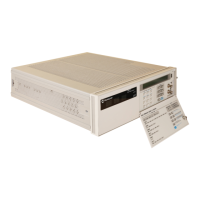Appendix A Performance Tests
5071A Complete Performance Tests
148 Operating and Programming Manual
Specifications
All spurious non-harmonic signals must be < -80 dBc with respect to the
fundamental frequency.
Procedure
If you are using the HP/Agilent 3585B Spectrum Analyzer, follow the steps
below to test for spurious signals on the 5 and 10 MHz outputs. If you are using
a different spectrum analyzer, use these steps as a guide for operation of that
analyzer.
1 Connect the 5071A Port 1 to the 3585B analyzer as shown in Figure A-4. Set the
3585B for 50 input impedance.
2 On the 5071A, set output ports 1 and 2 to 10 MHz using the front-panel controls.
See the section ―Setting the Output Port Frequency‖ in Chapter 2, ―Using the
5071A,‖ of this manual for instructions on how to perform this.
3 On the 3585B, perform the following steps:
a. Press the green INSTR PRESET button and allow the analyzer to go through
its auto range algorithm (this will take about 5 seconds).
b. Press the DISP LINE (display line) button in the marker menu and adjust the
line to -80.0 dBc.
c. Press the PEAK SEARCH button and then the MKR->REF LVL button
(both are in the marker menu area).
d. Set both the resolution bandwidth (RES BW) and the video bandwidth
(VIDEO BW) to 1 kHz. Enter the 1 kHz values using the numeric and unit
keys. The RES BW and VIDEO BW values are displayed at the bottom of
the screen.
The sweep time is 125 seconds. DO NOT adjust the sweep time
manually.
e. Press the CONT button in the sweep menu area to begin a new sweep.
f. When the new sweep has passed through the fundamental frequency, press the PEAK
SEARCH button again. Then press the OFFSET and the ENTER OFFSET buttons in
the marker menu area. Verify that both the offset frequency (Hz) and the offset level
(dB) go to zero (0 Hz and 0 dB should be displayed at the top of the screen). If
necessary, press and hold the ENTER OFFSET button to zero-out the marker offsets.

